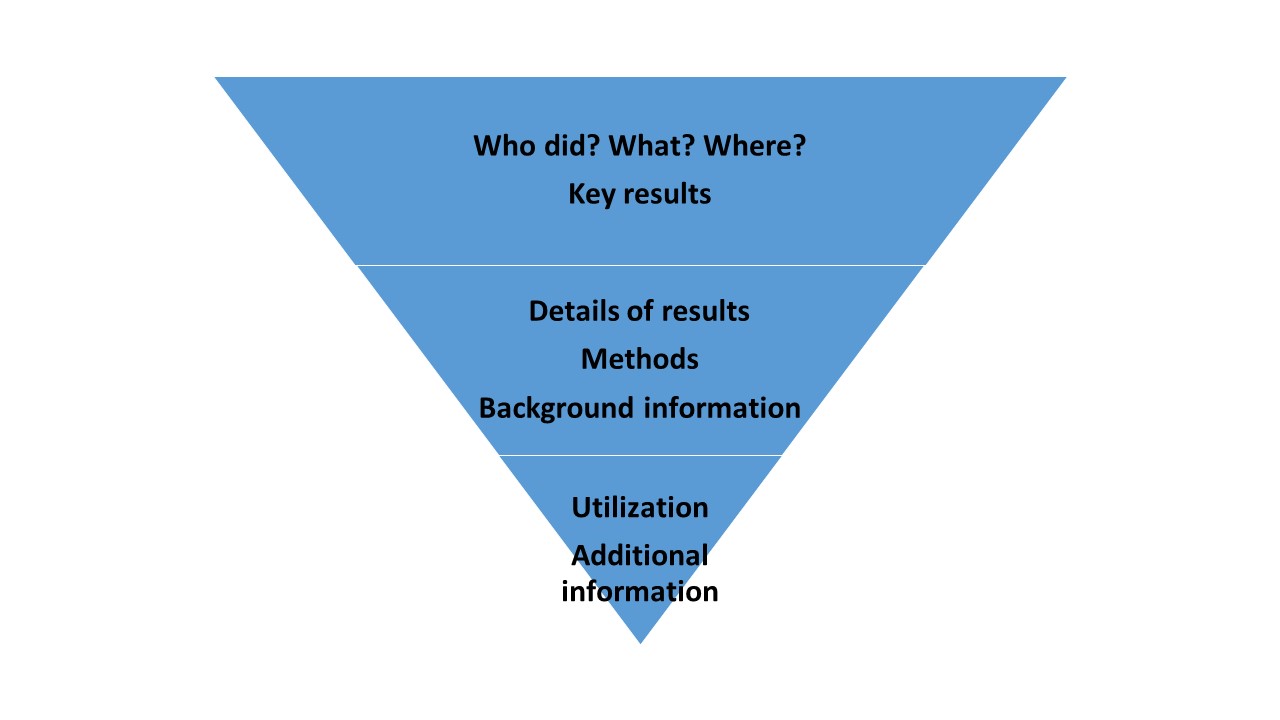9.1 Maturity Test as a Bulletin
The Finnish law requires the higher education students to proof their factual knowledge and language skills with a written maturity test. In bachelor’s degrees the maturity test is written as an internal bulletin. In master’s degrees the maturity test is a media release. The instructions on these pages are applied to both bulletin types, unless otherwise is stated.
The purpose of a bulletin is to be a comprehensible and interesting news item about the thesis. The target group of the internal bulletin is members of the Jamk community, the students and staff, while the media release is targeted at the media, and the reader of a news story that is written based on the media release could be anyone. As the student writes the bulletin, they consider what the thesis offers and signifies and highlights their professional skills to a wider audience.
When you write the bulleting, you reflect on the contribution and relevance of your thesis and highlight your professional skills to a wide audience. Make it concise and clear in both content and layout so that the main message is easily understood by the reader. Write in a flawless style that is appropriate for your audience.
The structure of the bulletin
Title and draft the bulletin or media release in a news-like manner, considering the target audience of the text. The bulletin or media release is not a thesis summary; it is not relevant to present the entire thesis. Highlight new, important and interesting results of the thesis at the beginning of the bulletin – do not try to fit in everything. The structure of a bulletin is similar to that of a news release, i.e. the most important information is given at the beginning of the release. Include new, important and interesting findings from the thesis at the beginning – you don’t have to include everything. The middle part of the release contains additional information, and the final part gives a more detailed presentation of the issues mentioned at the beginning, for example with background information. At the end, add the contact details of the person who provided the additional information, i.e. your own details. The structure of a bulletin is presented in Figure 1.

Writing instructions
In the first paragraph, write who did what, where, and the most interesting results of the work. You can start with the most interesting point (= lead) or by introducing, for example, ‘Oili Opiskelija, a logistics student at Jamk University of Applied Sciences, found in her thesis that…’ (who did what, where). According to the research,… (main result and significance). Do not write in the first person; write as an external observer. Do not refer to yourself as a student or researcher except when mentioning who wrote the thesis, but use your full name initially and then just your surname in any subsequent mentions. The main focus should be on the subject, not the person. Remember to mention Jamk University of Applied Sciences, and to spell and capitalize the full name of the school correctly.
Create the title based on the content of the first paragraph. Condense the usefulness of the thesis into the title in news style. For example, SME’s Also Benefit From New Technology. The headline of the release is not the title of the thesis.
Then, give a little detail about the execution of the thesis. Next, give any background information and conclude with how the results can be utilized or taken advantage of. Remember to divide the text into paragraphs. Do not detail each step of the progress; focus on the results. Do not use research method terminology.
A paragraph break is indicated by an empty line. The ideal length of the release is one page, which equates to approximately 300-400 words (3,000-3,500 characters). Mark the contact information at the end. Contact information is not included in the length of the text. Remember, the release is not a summary or a ready-made article about the thesis but rather source text for news. Do not use lists in the text; explain with good, complete sentences. The beginning of the release should cover the most important news-worthy items, with background details explained later. So, choose the important and interesting things.
Contact information (replace with your own):
Maija Meikäläinen, field of study, degree programme, Jamk University of Applied Sciences. Jyväskylä. email.address@xxx.com
Meikäläinen, M. (2023). Title of the Thesis. [Bachelor’s/Master’s thesis, Jamk University of Applied Sciences].
Thesis supervisors:
Confidential information in the maturity test
Even though all theses are intended for the public, sometimes a thesis may contain confidential information. The student is obliged to comply with the confidentiality principles in their maturity test. The maturity test does not usually disclose the name of or any other details concerning the commissioner/client. Focus on a newsworthy items, which can be something other than the primary results of the thesis. It can be about the process, methods, the background, etc. The perspective can broaden and further generalize the thesis subject. To summarize, do not disclose confidential information in your maturity test.
Updated 25.4.2025